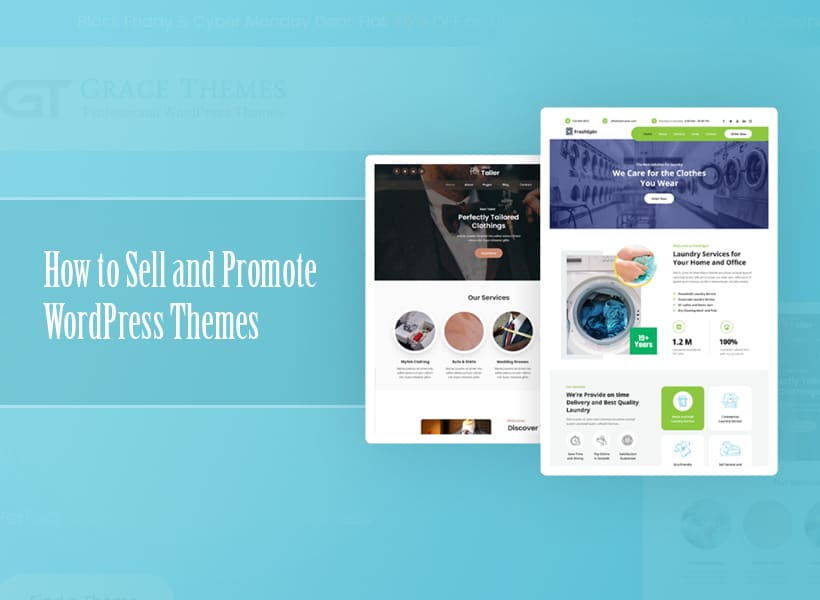How to Sell and Promote WordPress Themes?

Selling WordPress themes can be a lucrative business venture, but only if it is done with proper planning and strategy.
Considering how vast the ocean of digital products is, WordPress themes often stand out as essential tools for anyone looking to build a website. WordPress stands out as a colossal platform, powering over 40% of all websites on the Internet. So, there is a market and a huge demand for WordPress themes, but you need all the details and steps to sell and promote your themes if you want to succeed.
This guide will take you through the various steps and strategies to make your themes not only stand out but also become a top choice for consumers.
Understanding the WordPress Theme Market Landscape
Before we get into the details of the actual promotion and selling of the WordPress themes, it’s a good idea to first paint the picture of the market, and fully understand the demands of your target audience.
-
Market Trends and Demand
The WordPress theme market is influenced by web design trends. Users today are well-informed and they know what they are looking for, such as responsive designs, clean layouts, and mobile-friendly solutions. In addition, there is a demand for themes integrated with e-commerce capabilities, as online shopping continues to surge.
-
Competition Analysis
Unfortunately, the WordPress theme market is very competitive, but there is still room for new enthusiasts with fresh ideas and perspectives. It’s a good time to use the competition to your advantage and see what’s selling the most, and what the customers want.
-
Customer Expectations
In addition to competition, you have to consider the well-informed customer base. Buyers expect more than visually appealing themes, and they want functionality. Look into creating themes that are user-friendly to set up, have different customization options, and that are compatible with plugins and tools.
-
Niche Opportunities
While general-purpose themes have broad appeal, there’s a growing market for themes catering to specific industries (like real estate, restaurants, or health and wellness) or specific functions (like e-commerce, portfolios, or educational sites).
Now, let’s see all the steps you need to take to promote and sell your WordPress themes.
1. Design with Excellence
The first step on this exciting journey is to create a perfect WordPress theme. Your WordPress themes should not just be functional; they need to be aesthetically pleasing and user-friendly. Invest time in ensuring your themes are responsive, customizable, and compatible with popular plugins. A well-designed theme is easier to market and can command a higher price.
2. Optimize for SEO
If you thought that Search Engine Optimization was just for websites, think again. Make sure that your theme’s code is clean and optimized for search engines. This will not only benefit your users but also improve your theme’s visibility in search results.
3. Create a Strong Online Presence
Building a strong online presence will help you promote and sell your themes easier. The key is to be current, present, and engaging. This not only positions you as an expert but also drives organic traffic to your website.
Here are a few ways to make your mark online:
- Create a professional website
- Be active on all social media channels
- Post regular blogs and updates
- Create engaging multimedia content
- Implement the best SEO strategies
- Consider email newsletters
- Engage with the community
4. Develop a Compelling ‘Sales Script’
A well-crafted sales script can be a game-changer. It’s not just about listing features; it’s about telling a story that resonates with your potential customers. Highlight the problems your theme solves, showcase its unique features, and explain how it can improve a website’s functionality and aesthetics. Remember, a good sales script connects emotionally and logically with the buyer.
5. Offer Exceptional Support
Your work is not done with a successful sale because post-purchase support can significantly influence customer satisfaction and lead to positive reviews and referrals. This means you are proactive in resolving issues, updating your themes, and offering help to keep up with the latest WordPress updates.
6. Offer Free Demos or Trials
Allowing potential customers to try before they buy is a powerful approach to increasing sales and trust in your product.
Here’s how you can effectively implement this strategy:
- Ensure that your demos are prominently displayed and easy to access on your website;
- Offer limited-time trial versions of your themes;
- Create guided tours within your demo that highlight key features and functionalities;
- Incorporate a way for users to give feedback during or after the demo or trial period;
- Make the transition from trial to purchase as seamless as possible;
- Provide excellent support during the trial period to set the stage for the product.
7. Attend and Sponsor Events
Participating in WordPress and tech-related events can increase your network and visibility. Consider sponsoring such events or speaking at them to showcase your expertise and themes. In addition, it’s a good idea to reach out to the WordPress community and ask plugin developers to promote your themes.
Best Places to Sell and Promote WordPress Themes
When it comes to selling your WordPress themes, choosing the right platforms can significantly impact your success.
Here are some of the best places to sell your themes:
- Theme Marketplaces such as Grace Themes
- Personal Website
- WordPress.org Theme Directory
- Creative Market
- Collaboration with Hosting Providers
- Digital Product Platforms – Gumroad and Sellfy
- Social Media and Online Forums (Facebook, Instagram and LinkedIn)
In Conclusion
Selling and promoting WordPress themes requires a mix of technical excellence, strategic marketing, and a deep understanding of your customers’ needs.
By following these steps and continually adapting to market trends, you can build a strong presence in the WordPress community and drive significant sales for your themes. Remember, it’s not just about creating a product; it’s about creating value that resonates with your users.


